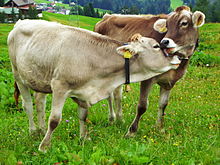Livestock is commonly defined as domesticated animals raised in an agricultural setting to produce labor and commodities such as meat, eggs, milk, fur, leather, and wool. The term is sometimes used to refer solely to those that are bred for consumption, while other times it refers only to farmed ruminants, such as cattle and goats.[1] Horses are considered livestock in the United States.[2] The USDA classifies pork, veal, beef, and lamb as livestock and all livestock as red meat. Poultry and fish are not included in the category.[3]
The breeding, maintenance, and slaughter of livestock, known as animal husbandry, is a component of modern agriculture that has been practiced in many cultures since humanity's transition to farming from hunter-gatherer lifestyles. Animal husbandry practices have varied widely across cultures and time periods, and continues to play a major economic and cultural role in numerous communities.
Livestock farming practices have largely shifted to intensive animal farming, sometimes referred to as "factory farming"; over 99% of livestock in the US are now raised in this way.[4] Intensive animal farming increases the yield of the various commercial outputs, but has also led to negative impacts on animal welfare, the environment, and public health.[5] Due to these negative impacts, but also for reasons of farming efficiency (see Food vs. feed), one projection mentions a large decline of livestock at least some animals (i.e. cattle) in certain countries by 2030.[6][7]
